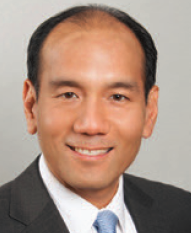It’s the age-old beauty of perspective. Is your glass half-full or half-empty?
One in 43 eyes, or 2.3 percent. That’s the proportion of patients with a Port Delivery System with ranibizumab (Susvimo) who had a septum dislodgement, according to a provider letter from Genentech/Roche. Most of those incidents came in the context of a refill-exchange procedure.
Along with data from a simulated aging analysis that showed the risk of septum dislodgement may increase with additional refill-exchanges, Genentech/Roche decided to voluntarily recall the device.
I’ve implanted dozens of these into patients with a variety of exudative retinal diseases in multiple clinical trial programs. The majority are very happy with their outcomes.
But, what percentage of unwanted outcomes is too high? Since the recall, most of these patients have chosen to delay additional refill-exchanges as long as possible to theoretically extend the life-span of the device.
Different patients and physicians can view the same risk-benefit ratio quite differently. For example, in the OAKS and DERBY Phase III trials, we observed a 12.2 percent rate of exudative age-related macular degeneration development with monthly pegcetacoplan compared to 3.1 percent with sham through two years.1 Is this risk too high?
Some physicians, myself included, believe that, in the absence of any other treatment, most patients will accept a potential side effect of wet AMD during treatment of geographic atrophy, knowing we can monitor and treat them as needed.
However, some physicians believe this risk profile, combined with the modest treatment effect of 16 to 22 percent reduction in GA growth through two years, may not be worth the benefit. With the Food and Drug Administration action date for pegcetacoplan set for early next year, it will be interesting to see how providers and patients interpret this risk-benefit ratio.
Artificial intelligence, as Yavuz Cakir, MD, and Justis P. Ehlers, MD, explore on page 36, may eventually help us determine which patients may benefit most from pharmacotherapy for GA and who may be most likely to develop exudative AMD.
Similarly, differences in perspective can lead to different approaches to rhegmatogenous retinal detachment repair.2 If two approaches achieve the same visual acuity outcome but one has a higher single-operation success rate while requiring more time and longer patient recovery, which would you choose? Which would your patient choose? Some surgeons are inclined to add a scleral buckle. Others see a large number needed to treat and decide against the hassle and increased recovery time. Same data; different applications.
How numbers impact your practice may depend on your perspective. RS
REFERENCES
1.Wykoff CC. Treatment of Geographic atrophy secondary to AMD with pegcetacoplan: Two-year outcomes from the randomized Phase 3 DERBY and OAKS Trials. Paper presented at American Academy of Ophthalmology Retina Subspecialty Day, Session RET10; Chicago, IL; September 30, 2022.
2.Ryan EH, Mittra RA. Surgeon judgment and the role of scleral buckle in addition to vitrectomy in eyes with retinal detachments. Ophthalmol Retina. 2022;6:869.
 |




